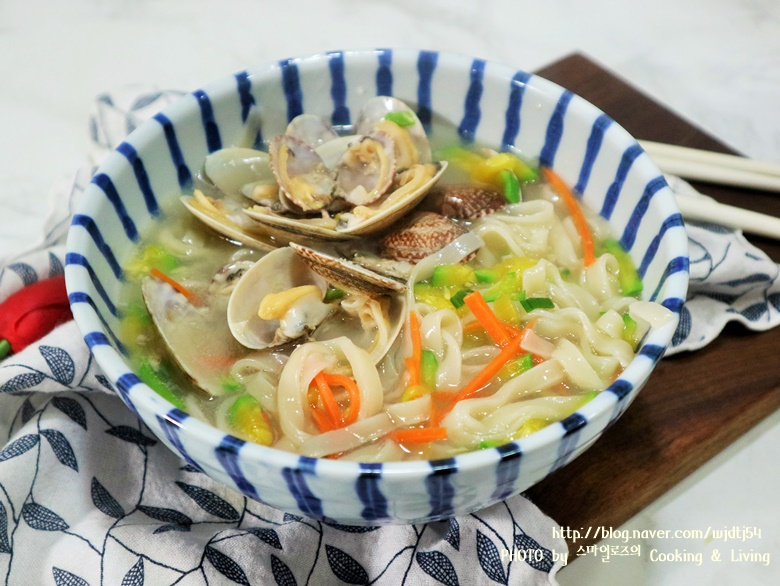Rich and Refreshing Clam Noodle Soup (Bajirak Kalguksu)
A Hearty Clam Noodle Soup Recipe with a Briny Broth and a Guide to Preparing Clams

With the gentle rain falling these past few days, a warm bowl of kalguksu (noodle soup) sounds absolutely perfect. As someone who loves seafood, clams, or ‘bajirak’ in particular, I often enjoy them in doenjang jjigae (soybean paste stew) or clear broths. Today, inspired by the drizzly weather, I’ve made a hearty bajirak kalguksu brimming with fresh clams. This beloved Korean comfort food, featuring plump clams, is a national favorite! #Clams #Bajirak #Kalguksu #SeafoodSoup #NoodleSoup #KoreanFood
Main Ingredients- 400g fresh clams
- 1 anchovy-kelp stock pack
- 1 serving fresh kalguksu noodles
- 1/2 zucchini
- A small piece of carrot
- 1 stalk green onion
- 1 chili pepper (optional, for spice)
Seasoning & Others- 1 Tbsp soup soy sauce
- 0.5 Tbsp minced garlic
- A pinch of coarse sea salt (for adjusting taste)
- A pinch of black pepper
- 1 Tbsp soup soy sauce
- 0.5 Tbsp minced garlic
- A pinch of coarse sea salt (for adjusting taste)
- A pinch of black pepper
Cooking Instructions
Step 1
First, it’s crucial to clean the clams thoroughly. Put on rubber gloves and place the clams in a pot or bowl. Scrub them vigorously under running water, rinsing multiple times until the water runs clear. This removes any grit or impurities. The name ‘bajirak’ is said to come from the sound they make (‘bajirak bajirak’), and they’ve long been known for their restorative properties. They are truly a top-tier ingredient that pairs well with any dish, and I personally could eat them every day!

Step 2
Clams purchased from supermarkets (water clams) generally contain less mud than those harvested from tidal flats, meaning they require less purging time. After rinsing the freshly delivered clams, it’s time to purge them. In a bowl, combine 1 liter of water with 4 tablespoons of coarse sea salt (ensure it’s coarse sea salt, not table salt). Stir until dissolved. Add a few stainless steel spoons to the water. Cover the bowl securely with a lid or plastic wrap, then place it in an icebox and let it sit for at least 2 hours. Important note: Regular salt or seasoned salt will not work for purging; only coarse sea salt is effective.

Step 3
To aid the purging process, it’s best to create a dark environment. Cover the bowl with a dark lid or a black plastic bag to block out light, and then refrigerate for 1-2 hours. For faster purging, adding an iron object like a spoon or coin can help the clams expel their grit more quickly. In my experience, leaving them in the icebox for 2 hours resulted in significantly less impurities compared to other purging methods.

Step 4
Once purged, the fresh clams can be used immediately in your cooking, or portioned and frozen for later use. You can separate the clam meat from the shells and freeze them individually, or freeze them with the shells still attached for easy use in soups and stews later.

Step 5
Now, let’s prepare the vegetables. We’ll use half of the zucchini, thinly sliced into matchsticks. One chili pepper, finely minced, adds a pleasant kick. (Optional tip: For an extra spicy kick, use minced pickled chili peppers instead). Shred a small amount of carrot for color. Finally, thinly slice the green onion for garnish.

Step 6
In a pot, combine the cleaned clams and the anchovy-kelp stock pack with water, and bring to a boil. Once the clams begin to open one by one, remove the stock pack. Strain this broth through a fine-mesh sieve or cheesecloth to achieve a clear and clean kalguksu soup base. This strained broth will be beautifully milky and deeply flavorful, almost like a restorative tonic. Return the anchovy-kelp stock pack to the strained clam broth and simmer a little longer to enhance the flavor. (Tip: Boiling the stock pack from the beginning can sometimes make the broth cloudy. It’s often better to remove the clams once they open, strain the broth separately, and then re-add the stock pack if desired.)

Step 7
Gently shake the fresh kalguksu noodles to separate them. The zucchini and carrots have already been julienned, and the green onions and chili pepper are also finely chopped. With all our ingredients prepped, let’s get ready to cook the kalguksu!

Step 8
Once the flavorful clam broth is boiling again, add the prepared fresh kalguksu noodles. As the noodles start to cook and loosen, add the julienned zucchini and carrots. Cook for the appropriate time, ensuring the noodles don’t become overcooked and mushy.

Step 9
When the noodles are almost tender, stir in 1 tablespoon of soup soy sauce and 0.5 tablespoon of minced garlic. Taste the broth and adjust the seasoning with coarse sea salt if needed. Finally, add the purged clams and simmer briefly until they are just cooked through. Avoid overcooking, as the clams can become tough. A final sprinkle of black pepper will complete your delicious bajirak kalguksu!

Step 10
This kalguksu, generously topped with fresh clams, boasts an incredibly refreshing and satisfying broth! On a day like today, with the rain falling, a steaming bowl of this noodle soup is truly a revitalizing meal. The chewy noodles and fresh clams create a fantastic combination.

Step 11
I doubt anyone dislikes clams! Bajirak are undoubtedly one of the most popular and beloved types of shellfish. They are incredibly versatile, used not only in kalguksu but also in pasta, clam boils, and many other dishes. Enjoy the wonderful chewy texture and the refreshingly deep flavor of these delicious clams in your next culinary creation.



